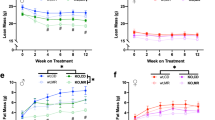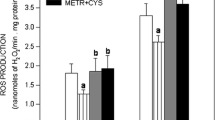Abstract
Reactive oxygen species-mediated oxidation of methionine residues in protein results in a racemic mixture of R and S forms of methionine sulfoxide (MetO). MetO is reduced back to methionine by the methionine sulfoxide reductases MsrA and MsrB. MsrA is specific toward the S form and MsrB is specific toward the R form of MetO. MsrB is a selenoprotein reported to contain zinc (Zn). To determine the effects of dietary selenium (Se) and Zn on Msr activity, CD-1 mice (N=16/group) were fed, in a 2×2 design, diets containing 0 or 0.2 μg Se/g and 3 or 15 ∥ Zn/g. As an oxidative stress, half of the mice received L-buthionine sulfoximine (BSO; ip; 2 mmol/kg, three times per week for the last 3 wk); the others received saline. After 9.5 wk, Msr (the combined specific activities of MsrA and MsrB) was measured in the brain, kidney, and liver. Se deficiency decreased (p<0.0001) Msr in all three tissues, but Zn had no direct effect. BSO treatment was expected to result in increased Msr activity; this was not seen. Additionally, we found that the ratio of MetO to methionine in liver protein was increased (indicative of oxidative damage) by Se deficiency. The results show that Se deficiency increases oxidation of methionyl residues in protein, that Se status affects Msr (most likely through effects on the selenoprotein MsrB), and that marginal Zn deficiency has little effect on Msr in liver and kidney. Finally, the results show that the oxidative effects of limited BSO treatment did not upregulate Msr activity.
Similar content being viewed by others
References
J. Gao, D. H. Yin, Y. Yao, et al., Loss of conformational stability in calmodulin upon methionine oxidation, Biophys. J. 74, 1115–1134 (1998).
R. Grimaud, B. Ezraty, J. K. Mitchell, et al., Repair of oxidized proteins. Identification of a new methionine sulfoxide reductase, J. Biol. Chem. 276, 48,915–48,920 (2001).
E. R. Stadtman, J. Moskovitz, B. S. Berlett, and R. L. Levine, Cyclic oxidation and reduction of protein methionine residues is an important antioxidant mechanism, Mol. Cell. Biochem. 234–235, 3–9 (2002).
J. Moskovitz, Methionine sulfoxide reductases: ubiquitous enzymes involved in antioxidant defense, protein regulation, and prevention of aging-associated diseases, Biochim. Biophys. Acta 1703, 213–219 (2005).
J. Moskovitz, J. M. Poston, B. S. Berlett, N. J. Nosworthy, R. Szczepanowski, and E. R. Stadtman, Identification and characterization of a putative active site for peptide methionine sulfoxide reductase (MsrA) and its substrate stereospecificity, J. Biol. Chem. 275, 14,167–14,172 (2000).
J. Moskovitz, V. K. Singh, J. Requena, B. J. Wilkinson, R. K. Jayaswal, and E. R. Stadtman, Purification and characterization of methionine sulfoxide reductases from mouse and Staphylococcus aureus and their substrate stereospecificity, Biochem. Biophys. Res. Commun. 290, 62–65 (2002).
G. V. Kryukov, R. A. Kumar, A. Koc, Z. Sun, and V. N. Gladyshev, Selenoprotein R is a zinc-containing stereo-specific methionine sulfoxide reductase, Proc. Natl. Acad. Sci. USA 99, 4245–4250 (2002).
S. Bar-Noy and J. Moskovitz, Mouse methionine sulfoxide reductase B: effect of selenocysteine incorporation on its activity and expression of the seleno-containing enzyme in bacterial and mammalian cells, Biochem. Biophys. Res. Commun. 297, 956 (2002).
T. C. Squier, Oxidative stress and protein aggregation during biological aging, Exp. Gerontol. 36, 1539–1550 (2001).
J. Moskovitz, H. Weissbach, and N. Brot, Cloning the expression of a mammalian gene involved in the reduction of methionine sulfoxide residues in proteins, Proc. Natl. Acad. Sci. USA 93, 2095–2099 (1996).
National Research Council, Nutrient Requirements of Laboratory Animals, 4th ed., National Academy Press, Washington, DC pp. 80–102 (1995).
P. G. Reeves, F. H. Nielsen, and G. C. Fahey, Jr., AIN-93 purified diets for laboratory rodents: final report of the American Institute of Nutrition ad hoc writing committee on the reformulation of the AIN-76A rodent diet, J. Nutr. 123, 1939–1951 (1993).
P. G. Reeves, Components of the AIN-93 diets as improvements in the AIN-76A diet, J. Nutr. 127, 838S-841S (1997).
P. Durand, L. J. Fortin, S. Lussier-Cacan, J. Davignon, and D. Blache, Hyperhomocysteinemia induced by folic acid deficiency and methionine load—applications of a modified HPLC method, Clin. Chim. Acta 252, 83–93 (1996).
D. Paglia and W. Valentine, Studies on the quantitative and qualitative characterization of erythrocyte glutathione peroxidase, J. Lab. Clin. Med. 70, 158–169 (1967).
K. J. Hintze, K. A. Wald, H. Zeng, E. H. Jeffery, and J. W. Finley, Thioredoxin reductase in human hepatoma cells is transcriptionally regulated by sulforaphane and other electrophiles via an antioxidant response element, J. Nutr. 133, 2721–2727 (2003).
J. Moskovitz and E. R. Stadtman, Selenium-deficient diet enhances protein oxidation and affects methionine sulfoxide reductase (MsrB) protein level in certain mouse tissues, Proc. Natl. Acad. Sci. USA 100, 7486–7490 (2003).
J. Moskovitz, B. S. Berlett, J. M. Poston, and E. R. Stadtman, The yeast peptide-methionine sulfoxide reductase functions as an antioxidant in vivo, Proc. Natl. Acad. Sci. USA 94, 9585–9589 (1997).
K. L. Maier, A. G. Lenz, I. Beck-Speier, and U. Costabel, Analysis of methionine sulfoxide in proteins, Methods Enzymol. 251, 455–461 (1995).
M. R. Schilling, H. P. Khanjian, and L. A. C. Souza, Gas chromatographic analysis of aminoa acids as ethyl chloroformate derivatives, J. Am. Inst. Conserv. 35, 45–59 (1996).
D. C. Turnell and J. D. Cooper, Rapid assay for amino acids in serum or urine by precolumn derivatization and reversed-phase liquid chromatography, Clin. Chem. 28, 527–531 (1982).
K. E. Hill and R. F. Burk, Effect of selenium deficiency and vitamin E deficiency on glutathione metabolism in isolated rat hepatocytes, J. Biol. Chem. 257, 10,668–10,672 (1982).
K. E. Hill and R. F. Burk, Effect of selenium deficiency on the disposition of plasma glutathione, Arch. Biochem. Biophys. 240, 166–171 (1985).
E. O. Uthus, K. Yokoi, and C. D. Davis, Selenium deficiency in Fisher-344 rats decreases plasma and tissue homocysteine concentrations and alters plasma homocysteine and cysteine redox status, J. Nutr. 132, 1122–1128 (2002).
E. O. Uthus and Y. J. Kang, Effect of buthionine sulfoximine on the response to arsenic deprivation in female rats, J. Trace Elements Exp. Med. 11, 29–36 (1998).
O. W. Griffith, Depletion of glutathione by inhibition of biosynthesis, Methods Enzymol. 77, 59–63 (1981).
O. W. Griffith, Mechanism of action, metabolism, and toxicity of buthionine sulfoximine and its higher homologs, potent inhibitors of glutathione synthesis, J. Biol. Chem. 257, 13,704–13,712 12 (1982).
V. N. Gladyshev and D. L. Hatfield, Selenocysteine-containing proteins in mammals, J. Biomed. Sci. 6, 151–160 (1999).
H. Tapiero, D. M. Townsend, and K. D. Tew, The antioxidant role of selenium and seleno-compounds, Biomed. Pharmacother. 57, 134–144 (2003).
M. M. Berggren, J. F. Mangin, J. R. Gasdaka, and G. Powis, Effect of selenium on rat thioredoxin reductase activity: increase by supranutritional selenium and decrease by selenium deficiency, Biochem. Pharmacol. 57, 187–193 (1999).
J. W. Finley, A. Sigrid-Keck, R. J. Robbins, and K. J. Hintze, Selenium enrichment of broccoli: interactions between selenium and secondary plant compounds, J. Nutr. 135, 1236–1238 (2005).
Author information
Authors and Affiliations
Rights and permissions
About this article
Cite this article
Uthus, E.O., Moskovitz, J. Specific activity of methionine sulfoxide reductase in CD-1 mice is significantly affected by dietary selenium but not zinc. Biol Trace Elem Res 115, 265–276 (2007). https://doi.org/10.1007/BF02686001
Received:
Accepted:
Issue Date:
DOI: https://doi.org/10.1007/BF02686001




